Monitoring Rock Glacier Kinematics with Satellite Synthetic Aperture Radar
Abstract
1. Introduction
2. Study Regions
2.1. Western Swiss Alps
2.2. Qeqertarsuaq (Greenland)
2.3. Tapado/Agua Negra Region (Chilean/Argentinian Andes)
3. Data and Methods
3.1. SAR Interferometry
3.2. SAR Offset Tracking
4. Results
4.1. Distelhorn Rock Glacier (Western Swiss Alps)
4.2. Tsarmine Rock Glacier (Western Swiss Alps)
4.3. Becs-de-Besson Rock Glacier (Western Swiss Alps)
4.4. Qeqertarsuaq (Greenland)
4.5. Dos Lenguas Rock Glacier (Agua Negra Region, Argentinian Andes)
5. Measurement Uncertainty
5.1. SAR Interferometry
5.2. SAR Offset Tracking
6. Discussion
7. Conclusions and Outlook
Author Contributions
Funding
Acknowledgments
Conflicts of Interest
References
- Haeberli, W.; Noetzli, J.; Arenson, L.; Delaloye, R.; Gärtner-Roer, I.; Gruber, S.; Isaksen, K.; Kneisel, C.; Krautblatter, M.; Phillips, M. Mountain permafrost: Development and challenges of a young research field. J. Glac. 2010, 56, 1043–1058. [Google Scholar] [CrossRef]
- Obu, J.; Westermann, S.; Bartsch, A.; Berdnikov, N.; Christiansen, H.; Dashtseren, A.; Delaloye, R.; Elberling, B.; Etzelmüller, B.; Kholodov, A.; et al. Northern Hemisphere permafrost map based on TTOP modelling for 2000–2016 at 1 km2 scale. Earth Sci. Rev. 2019, 193, 299–316. [Google Scholar] [CrossRef]
- Delaloye, R.; Lambiel, C.; Gärtner-Roer, I. Overview of rock glacier kinematics research in the Swiss Alps: Seasonal rhythm, interannual variations and trends over several decades. Geogr. Helv. 2010, 65, 135–145. [Google Scholar] [CrossRef]
- Haeberli, W.; Hallet, B.; Arenson, L.; Elconin, R.; Humlum, O.; Kääb, A.; Kaufmann, V.; Ladanyi, B.; Matsuoka, N.; Springman, S.; et al. Permafrost Creep and Rock Glacier Dynamics. Permafr. Periglac. Process. 2006, 17, 189–214. [Google Scholar] [CrossRef]
- Kääb, A. Remote sensing of permafrost-related problems and hazards. Permafr. Periglac. Process. 2008, 19, 107–136. [Google Scholar] [CrossRef]
- Hock, R.; Rasul, G.; Adler, C.; Cáceres, B.; Gruber, S.; Hirabayashi, Y.; Jackson, M.; Kääb, A.; Kang, S.; Kutuzov, S.; et al. High Mountain Areas. In IPCC Special Report on Ocean and the Cryosphere in a Changing Climate (SROCC); IPCC: Geneva, Switzerland, 2019. [Google Scholar]
- Azócar, G.F.; Brenning, A. Hydrological and geomorphological significance of rock glaciers in the dry Andes, Chile (27°–33°S). Permafr. Periglac. Process. 2010, 21, 42–53. [Google Scholar] [CrossRef]
- Anderson, R.S.; Anderson, L.S.; Armstrong, W.H.; Rossi, M.W.; Crump, S.E. Glaciation of alpine valleys: The glacier—Debris-covered glacier—Rock glacier continuum. Geomorphology 2018, 311, 127–142. [Google Scholar] [CrossRef]
- Jones, D.B.; Harrison, S.; Anderson, K.; Whalley, W.B. Rock glaciers and mountain hydrology: A review. Earth Sci. Rev. 2019, 193, 66–90. [Google Scholar] [CrossRef]
- Humlum, O. Origin of Rock Glaciers: Observations from Mellemfjord, Disko Island, Central West Greenland. Permafr. Periglac. Process. 1996, 7, 361–380. [Google Scholar] [CrossRef]
- Degenhardt, J.J., Jr. Development of tongue-shaped and multilobate rock glaciers in alpine environments—Interpretations from ground penetrating radar surveys. Geomorphology 2009, 109, 94–107. [Google Scholar] [CrossRef]
- Humlum, O. Rock glacier types on Disko, central West Greenland. Geogr. Tidsskr. Dan. J. Geogr. 1982, 82, 59–66. [Google Scholar] [CrossRef]
- Martin, H.E.; Whalley, W.B. Rock glaciers part 1: Rock glacier morphology: Classification and distribution. Prog. Phys. Geogr. Earth Environ. 1987, 11, 260–282. [Google Scholar] [CrossRef]
- Delaloye, R.; Staub, B. Seasonal variations of rock glacier creep: Time series observations from the Western Swiss Alps. In Proceedings of the International Conference on Book of Abstracts, Potsdam, Germany, 20–24 June 2016. [Google Scholar]
- Kaufmann, V.; Kellerer-Pirklbauer, A. Active Rock Glaciers in a Changing Environment. Geomorphometric Quantification and Cartographic Presentation of Rock Glacier Surface Change with Examples from the Hohe Tauern Range, Austria. In Mountain Cartography. 16 Years ICA Commission on Mountain Cartography (1999–2015) Wiener Schriften zur Geographie und Kartographie, 21; Institut für Geographie und Regionalforschung, Universität Wien: Wien, Austria, 2015; pp. 179–190. ISBN 978-3-900830-86-1. [Google Scholar]
- Staub, B.; Lambiel, C.; Delaloye, R. Rock glacier creep as a thermally-driven phenomenon: A decade of inter-annual observations from the Swiss Alps. In Proceedings of the International Conference on Permafrost—Book of Abstracts, Potsdam, Germany, 20–24 June 2016. [Google Scholar]
- Eriksen, H.; Rouyet, L.; Lauknes, T.R.; Berthling, I.; Isaksen, K.; Hindberg, H.; Larsen, Y.; Corner, G. Recent Acceleration of a Rock Glacier Complex, Ádjet, Norway, Documented by 62 Years of Remote Sensing Observations. Geophys. Res. Lett. 2018. [Google Scholar] [CrossRef]
- PERMOS. Permafrost in Switzerland 2010/2011 to 2013/2014; Noetzli, J., Luethi, R., Staub, B., Eds.; Glaciological Report (Permafrost) No. 12–15; Cryospheric Commission of the Swiss Academy of Sciences: Bern, Switzerland, 2016. [Google Scholar]
- Delaloye, R.; Perruchoud, E.; Avian, M.; Kaufmann, V.; Bodin, X.; Hausmann, H.; Ikeda, A.; Kääb, A.; Kellerer-Pirklbauer, A.; Krainer, K.; et al. Recent interannual variations of rock glacier creep in the European Alps. In Proceedings of the 9th International Conference on Permafrost, Fairbanks, AK, USA, 29 June–3 July 2008. [Google Scholar]
- Kellerer-Pirklbauer, A.; Delaloye, R.; Lambiel, C.; Gärtner-Roer, I.; Kaufmann, V.; Scapozza, C.; Krainer, K.; Staub, B.; Thibert, E.; Bodin, X.; et al. Interannual variability of rock glacier flow velocities in the European Alps. In Proceedings of the 5th European Conference on Permafrost (EUCOP5-2018), Chamonix, France, 23 June–1 July 2018. [Google Scholar]
- Ikeda, A.; Matsuoka, N.; Kääb, A. Fast deformation of perennially frozen debris in a warm rock glacier in the Swiss Alps: An effect of liquid water. J. Geophys. Res. 2008, 113, F01021. [Google Scholar] [CrossRef]
- Cicoira, A.; Beutel, J.; Faillettaz, J.; Gärtner-Roer, I.; Vieli, A. Resolving the influence of temperature forcing through heat conduction on rock glacier dynamics: A numerical modelling approach. Cryosphere 2019, 13, 927–942. [Google Scholar] [CrossRef]
- Kääb, A.; Frauenfelder, R.; Roer, I. On the response of rockglacier creep to surface temperature increases. Glob. Planet. Chang. 2007, 56, 172–187. [Google Scholar] [CrossRef]
- Rignot, E.; Hallet, B.; Fountain, A. Rock glacier surface motion in Beacon Valley, Antarctica, from synthetic-aperture radar interferometry. Geophys. Res. Lett. 2002. [Google Scholar] [CrossRef]
- Kenyi, L.W.; Kaufmann, V. Estimation of rock glacier surface deformation using SAR interferometry data. IEEE Trans. Geosci. Remote Sens. 2003, 41, 1512–1515. [Google Scholar] [CrossRef]
- Strozzi, T.; Kääb, A.; Frauenfelder, R. Detecting and quantifying mountain permafrost creep from in situ inventory, space-borne radar interferometry and airborne digital photogrammetry. Int. J. Rem. Sens. 2004, 25, 2919–2931. [Google Scholar] [CrossRef]
- Liu, L.; Millar, C.I.; Westfall, R.D.; Zebker, H.A. Surface motion of active rock glaciers in the Sierra Nevada, California, USA: Inventory and a case study using InSAR. Cryosphere 2013, 7, 1109. [Google Scholar] [CrossRef]
- Lilleøren, K.; Etzelmüller, B.; Gärtner-Roer, I.; Kääb, A.; Westermann, S.; Gudmundsson, A. The Distribution, Thermal Characteristics and Dynamics of Permafrost in Trollaskagi, Northern Iceland, as Inferred from the Distribution of Rock Glaciers and Ice-Cored Moraines. Permafr. Periglac. Process. 2013, 24, 322–335. [Google Scholar] [CrossRef]
- Barboux, C.; Delaloye, R.; Lambiel, C. Inventorying slope movements in an Alpine environment using DinSAR. Earth Surf. Process. Landf. 2014, 39, 2087–2099. [Google Scholar] [CrossRef]
- Rick, B.; Delaloye, R.; Barboux, C.; Strozzi, T. Detection and inventorying of slope movements in the Brooks Range, Alaska using DInSAR: A test study. In Proceedings of the GEOQuébec 2015: 68th Canadian Geotechnical Conference and 7th Canadian Permafrost Conference, Quebec City Convention Centre, Québec, QC, Canada, 20–23 September 2015. [Google Scholar]
- Necsoiu, M.; Onaca, A.; Wigginton, S.; Urdea, P. Rock glacier dynamics in Southern Carpathian Mountains from high-resolution optical and multi-temporal SAR satellite imagery. Remote Sens. Environ. 2016, 177, 21–36. [Google Scholar] [CrossRef]
- Wang, X.; Liu, L.; Zhao, L.; Wu, T.; Li, Z.; Liu, G. Mapping and inventorying active rock glaciers in the northern Tien Shan of China using satellite SAR interferometry. Cryosphere 2017, 11, 997–1014. [Google Scholar] [CrossRef]
- Villarroel, C.D.; Tamburini Beliveau, G.; Forte, A.P.; Monserrat, O.; Morvillo, M. DInSAR for a Regional Inventory of Active Rock Glaciers in the Dry Andes Mountains of Argentina and Chile with Sentinel-1 Data. Remote Sens. 2018, 10, 1588. [Google Scholar] [CrossRef]
- Torres, R.; Snoeij, P.; Geudtner, D.; Bibby, D.; Davidson, M.; Attema, E.; Potin, P.; Rommen, B.; Floury, N.; Brown, M.; et al. GMES Sentinel-1 mission. Remote Sens. Environ. 2012, 120, 9–24. [Google Scholar] [CrossRef]
- Strozzi, T.; Murray, T.; Wegmüller, U.; Werner, C. Glacier Motion Estimation Using SAR Offset-Tracking Procedures. IEEE Trans. Geosci. Remote Sens. 2002, 40, 2384–2391. [Google Scholar] [CrossRef]
- Paul, P.; Bolch, T.; Briggs, K.; Kääb, A.; McMillan, M.; McNabb, R.; Nagler, T.; Nuth, C.; Rastner, P.; Strozzi, T.; et al. Error sources and guidelines for quality assessment of glacier area, elevation change, and velocity products derived from satellite data. Remote Sens. Environ. 2017, 203, 256–275. [Google Scholar] [CrossRef]
- Barboux, C.; Strozzi, T.; Delaloye, R.; Wegmüller, U.; Collet, C. Mapping slope movements in Alpine environments using TerraSAR-X interferometric methods. J. Photogramm. Remote Sens. 2015, 109, 178–192. [Google Scholar] [CrossRef]
- Delaloye, R.; Morand, S. Du Val Ferret au Grand-Combin (Alpes Valaisannes): Inventaire des glaciers rocheux et analyse spatiale du pergélisol à l’aide d’un système d’information géographique (IDRISI). Master’s Thesis, University of Fribourg, Fribourg, Switzerland, 1997. [Google Scholar]
- Lambiel, C.; Reynard, E. Cartographie de la distribution du pergélisol et datation des glaciers rocheux dans la région du Mont Gelé (Valais). In Entwicklungstendenzen und Zukunftsperspektiven in der Geomorphologie; Physische Geographie: 91–103; Universität Zürich, Geographisches Institut: Zürich, Switzerland, 2003. [Google Scholar]
- Delaloye, R.; Strozzi, T.; Lambiel, C.; Barboux, C.; Mari, S.; Stocker, A.; Techel, F.; Raetzo, H. The contribution of InSAR data to the early detection of potentially hazardous active rock glaciers in mountain areas. In Proceedings of the ESA Living Planet Symposium 2010, Bergen, Norway, 28 June–2 July 2010. [Google Scholar]
- Marcer, M.; Serrano, C.; Brenning, A.; Bodin, X.; Goetz, J.; Schoeneich, P. Evaluating the destabilization susceptibility of active rock glaciers in the French Alps. Cryosphere 2019, 13, 141–155. [Google Scholar] [CrossRef]
- Kummert, M.; Delaloye, R. Mapping and quantifying sediment transfer between the front of rapidly moving rock glaciers and torrential gullies. Geomorphology 2018, 309, 60–76. [Google Scholar] [CrossRef]
- Delaloye, R.; Lambiel, C. Suivis par GPS et webcam de glaciers rocheux à mouvement rapide. In Monitoring En Milieux Naturels—Retours D’expériences En Terrains Difficiles; Collection EDYTEM 19, Presses universitaires Savoie Mont Blanc: Le Bourget du Lac, France, 2017; pp. 37–46. [Google Scholar]
- Wirz, V.; Beutel, J.; Gruber, S.; Gubler, S.; Purves, R.S. Estimating velocity from noisy GPS data for investigating the temporal variability of slope movements. Nat. Hazards Earth Syst. Sci. 2014, 14, 2503–2520. [Google Scholar] [CrossRef]
- Papke, J.; Strozzi, T.; Tate, N. Mapping Land Surface Displacements in the Swiss Alps with Radar Interferometry. In Earth Observation for Land and Emergency Monitoring; Balzter, H., Ed.; John Wiley & Sons, Ltd: Chichester, UK, 2017. [Google Scholar] [CrossRef]
- Yde, J.C.; Knudsen, N.T. 20th-century glacier fluctuations on Disko Island (Qeqertarsuaq), Greenland. Ann. Glaciol. 2007, 46, 209–214. [Google Scholar] [CrossRef]
- Porter, C.; Morin, P.; Howat, I.; Noh, M.-J.; Bates, B.; Peterman, K.; Keesey, S.; Schlenk, M.; Gardiner, J.; Tomko, K.; et al. ArcticDEM, Harvard Dataverse, V1 2018. Available online: https://doi.org/10.7910/DVN/OHHUKH (accessed on 20 November 2019).
- Hollesen, J.; Buchwal, A.; Rachlewicz, G.; Hansen, B.U.; Hansen, M.O.; Stecher, O.; Elberling, B. Winter warming as an important co-driver for Betula nana growth in western Greenland during the past century. Glob. Chang. Biol. 2015, 21, 2410–2423. [Google Scholar] [CrossRef]
- Geological Map of Greenland 1: 500,000; Søndre Strømfjord (Nûgssuaq) (Sheet 3): 55.67 (Grønlands geologi og palæontologi i alm.); Geological Survey of Denmark and Greenland: København, Denmark, 1997.
- Pourrier, J.; Jourde, H.; Kinnard, C.; Gascoin, S.; Monnier, S. Glacier meltwater flow paths and storage in a geomorphologically complex glacial foreland: The case of the Tapado glacier, dry Andes of Chile (30°S). J. Hydrol. 2014, 519, 1068–1083. [Google Scholar] [CrossRef]
- Azócar, G.F.; Brenning, A.; Bodin, X. Permafrost distribution modelling in the semi-arid Chilean Andes. Cryosphere 2017, 11, 877–890. [Google Scholar] [CrossRef]
- Falvey, M.; Garreaud, R.D. Regional cooling in a warming world: Recent temperature trends in the southeast Pacific and along the west coast of subtropical South America (1979–2006). J. Geophys. Res. 2009, 114. [Google Scholar] [CrossRef]
- Schrott, L. The hydrological significance of high mountain permafrost and its relation to solar radiation. A case study in the high Andes of San Juan, Argentina. Bamberger Geographische Schriften, Bd. 1998, 15, 71–84. [Google Scholar]
- Monnier, S.; Kinnard, C. Reconsidering the glacier to rock glacier transformation problem: New insights from the central Andes of Chile. Geomorphology 2015, 238. [Google Scholar] [CrossRef]
- Schaffer, N.; MacDonell, S.; Réveillet, M.; Yáñez, E.; Valois, R. Rock glaciers as a water resource in a changing climate in the semiarid Chilean Andes. Reg. Environ. Chang. 2019. [Google Scholar] [CrossRef]
- Arenson, L.; Matthias, J. The significance of rock glaciers in the dry Andes—A discussion of Azócar and Brenning (2010) and Brenning and Azócar (2010). Permafr. Periglac. Process. 2010, 21, 282–285. [Google Scholar] [CrossRef]
- Brenning, A. The Impact of Mining on Rock Glaciers. In Darkening Peaks: Glacier Retreat, Science, and Society; Orlove, B.S., Wiegandt, E., Luckman, B., Eds.; University of California Press: Berkeley, CA, USA, 2008; Chapter 14; pp. 196–205. [Google Scholar]
- IANIGLA. Inventario Nacional de Glaciares Y Ambiente Periglacial: Fundamentos Y Cronograma de Ejecución; IANIGLA: Mendoza, Argentina, 2010. [Google Scholar]
- UGP-UC. Dinámica de Glaciares Rocosos En El Chile Semiárido. Unidad de glaciología y nieves; DGA/MOP; UGP-UC: Santiago, Chile, 2011. [Google Scholar]
- Trombotto, D.; Borzotta, E. Indicators of present global warming through changes in active layer-thickness, estimation of thermal diffusivity and geomorphological observations in the Morenas Coloradas rockglacier, Central Andes of Mendoza, Argentina. Cold Reg. Sci. Technol. 2009, 55, 321–330. [Google Scholar] [CrossRef]
- Bodin, X.; Krysiecki, J.-M.; Iribarren Anacona, P. Recent collapse of rock glaciers: Two study cases in the Alps and in the Andes. In Proceedings of the 12th Congress INTERPRAEVENT, Grenoble, France, 23–26 April 2012; pp. 2–3. [Google Scholar]
- CEAZA. Caracterización Y Monitoreo De Glaciares Rocosos En La Cuenca Del Río Elqui, Y Balance De Masa Del Glaciar Tapado; MOP-DGA: Santiago, Chile, 2012. [Google Scholar]
- Vivero, S.; MacDonell, S.; Bodin, X.; Robson, B.; Schaffer, N.; Lambiel, C. Debris-covered glacier and rock glacier kinematics in the Chilean Andes (30°S), documented by 64 years of remote sensing and in situ observations. In Proceedings of the 1st Southern Hemisphere Conference on Permafrost 2019, Queenstown, New Zealand, 4–14 December 2019. [Google Scholar]
- Halla, C.; Blöthe, J.; Tapia Baldis, C.; Trombotto, D.; Hilbich, C.; Hauck, C.; Schrott, L. Ice content and interannual water storage changes of an active rock glacier in the dry Andes of Argentina. Cryosphere. (submitted).
- Bodin, X.; Echelard, T.; Lacroix, P.; Strozzi, T. Regional evaluation of rock glacier activity in the semi-arid Andes using optical and radar satellite imagery. In Proceedings of the 5th European Conference on Permafrost 2018, Book of Abstract, Laboratoire EDYTEM, Chamonix, France, 23 June–1 July 2018; pp. 386–387. [Google Scholar]
- Bamler, R.; Hartl, P. Synthetic aperture radar interferometry. Inverse Probl. 1998, 14, R1–R54. [Google Scholar] [CrossRef]
- Rosen, P.; Hensley, S.; Joughin, I.; Li, F.; Madsen, S.; Rodriguez, E.; Goldstein, R. Synthetic aperture radar interferometry. Proc. IEEE 2000, 88, 333–382. [Google Scholar] [CrossRef]
- Strozzi, T.; Delaloye, R.; Kääb, A.; Ambrosi, C.; Perruchoud, E.; Wegmüller, U. Combined observations of rock mass movements using satellite SAR inteferometry, differential GPS, airborne digital photogrammetry, and airborne photography interpretation. J. Geophys. Res. 2010, 115, F01014. [Google Scholar] [CrossRef]
- De Zan, F.; Guarnieri, A. TOPSAR: Terrain Observation by Progressive Scans. IEEE Trans. Geosci. Remote Sens. 2006, 44, 2352–2360. [Google Scholar] [CrossRef]
- Nemoto, Y.; Nishino, H.; Ono, M.; Mizutamari, H.; Nishikawa, K.; Tanaka, K. Japanese earth resources satellite-1 synthetic aperture radar. Proc. IEEE 1991, 79, 800–809. [Google Scholar] [CrossRef]
- Pitz, W.; Miller, D. The TerraSAR-X satellite. IEEE Trans. Geosci. Remote Sens. 2010, 48, 615–622. [Google Scholar] [CrossRef]
- Werner, C.; Wegmüller, U.; Strozzi, T.; Wiesmann, A. Gamma SAR and interferometric processing software. In Proceedings of the ERS-ENVISAT Symposium, Gothenburg, Sweden, 16–20 October 2000. [Google Scholar]
- Wessel, B. TanDEM-X Ground Segment—DEM Products Specification Document, EOC, DLR, Oberpfaffenhofen, Germany, Public Document TD-GS-PS-0021, Issue 3.1. 2016. Available online: https://tandemx-science.dlr.de (accessed on 5 July 2018).
- Wegmüller, U.; Werner, C.; Strozzi, T.; Wiesmann, A.; Frey, O.; Santoro, M. Sentinel-1 Support in the GAMMA Software. Procedia Comput. Sci. 2016, 100, 1305–1312. [Google Scholar] [CrossRef]
- Strozzi, T.; Farina, P.; Corsini, A.; Ambrosi, C.; Thüring, M.; Zilger, J.; Wiesmann, A.; Wegmüller, U.; Werner, C. Survey and monitoring of landslide displacements by means of L-band satellite SAR interferometry. Landslides 2005, 2, 193–201. [Google Scholar] [CrossRef]
- Gray, L.; Mattar, K.; Vachon, P. InSAR Results from the RADARSAT Antarctic Mapping Mission: Estimation of Glacier Motion Using A Simple Registration Procedure. IEEE IGARSS’98 Proceedings; IEEE: Seattle, WA, USA, 1998. [Google Scholar]
- Paul, P.; Bolch, T.; Kääb, A.; Nagler, T.; Nuth, C.; Scharrer, K.; Shepherd, A.; Strozzi, T.; Ticconi, F.; Bhambri, R.; et al. The glaciers climate change initiative: Methods for creating glacier area; elevation change and velocity products. Remote Sens. Environ. 2015, 162, 408–426. [Google Scholar] [CrossRef]
- Werner, C.; Wegmüller, U.; Strozzi, T.; Wiesmann, A. Precision estimation of local offsets between SAR SLCs and detected SAR images. In Proceedings of the IGARSS 2005, Seoul, Korea, 25–29 July 2005. [Google Scholar]
- Virelli, M.; Coletta, A.; Battagliere, M.L. ASI COSMO-SkyMed: Mission Overview and Data Exploitation. IEEE Geosci. Remote Sens. Mag. 2014, 2, 64–66. [Google Scholar] [CrossRef]
- Crosetto, M.; Monserrat, O.; Bremmer, C.; Hanssen, R.; Capes, R.; Marsh, S. Ground motion monitoring using SAR interferometry: Quality assessment. Eur. Geol. 2009, 26, 12–15. [Google Scholar]
- Sandwell, D.; Myer, D.; Mellors, R.; Shimada, M.; Brooks, B.; Foster, J. Accuracy and Resolution of ALOS Interferometry: Vector Deformation Maps of the Father’s Day Intrusion at Kilauea. IEEE Trans. Geosci. Remote Sens. 2008, 46, 3524–3534. [Google Scholar] [CrossRef]
- Lambiel, C.; Delaloye, R. Contribution of real-time kinematic GPS in the study of creeping mountain permafrost: Examples from the Western Swiss Alps. Permafr. Periglac. Process. 2004, 15, 229–241. [Google Scholar] [CrossRef]
- Kääb, A.; Vollmer, M. Surface geometry, thickness changes and flow fields on creeping mountain permafrost: Automatic extraction by digital image analysis. Permafr. Periglac. Process. 2000, 11, 315–326. [Google Scholar] [CrossRef]
- Debella-Gilo, M.; Kääb, A. Sub-pixel precision image matching for measuring surface displacements on mass movements using normalized cross-correlation. Remote Sens. Environ. 2010, 115, 130–142. [Google Scholar] [CrossRef]
- Global Terrestrial Network for Permafrost (GTN-P). Available online: https://gtnp.arcticportal.org (accessed on 22 May 2019).
- Kellerer-Pirklbauer, A.; Kaufmann, V. About the relationship between rock glacier velocity and climate parameters in central Austria. Austrian J. Earth Sci. 2012, 105, 94–112. [Google Scholar]
- Sorg, A.; Kääb, A.; Roesch, A.; Bigler, C.; Stoffel, M. Contrasting responses of Central Asian rock glaciers to global warming. Sci. Rep. 2015, 5, 8228. [Google Scholar] [CrossRef]
- Delaloye, R.; Barboux, C.; Bodin, X.; Brenning, A.; Hartl, L.; Hu, Y.; Ikeda, A.; Kaufmann, V.; Kellerer-Pirklbauer, A.; Lambiel, C.; et al. Rock glacier inventories and kinematics: A new IPA Action Group. In Proceedings of the 5th European Conference on Permafrost (EUCOP5-2018), Chamonix, France, 23 June–1 July 2018. [Google Scholar]
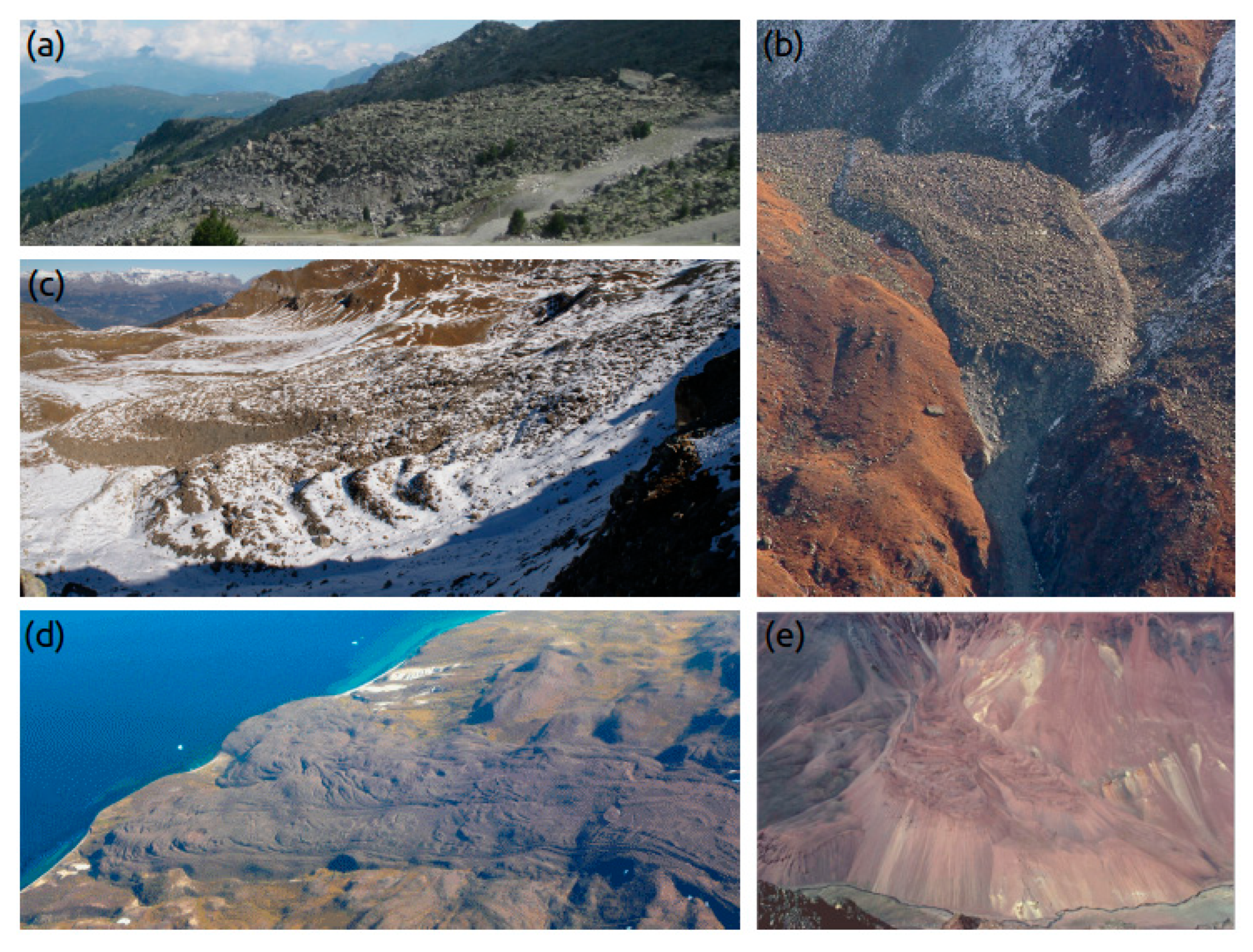
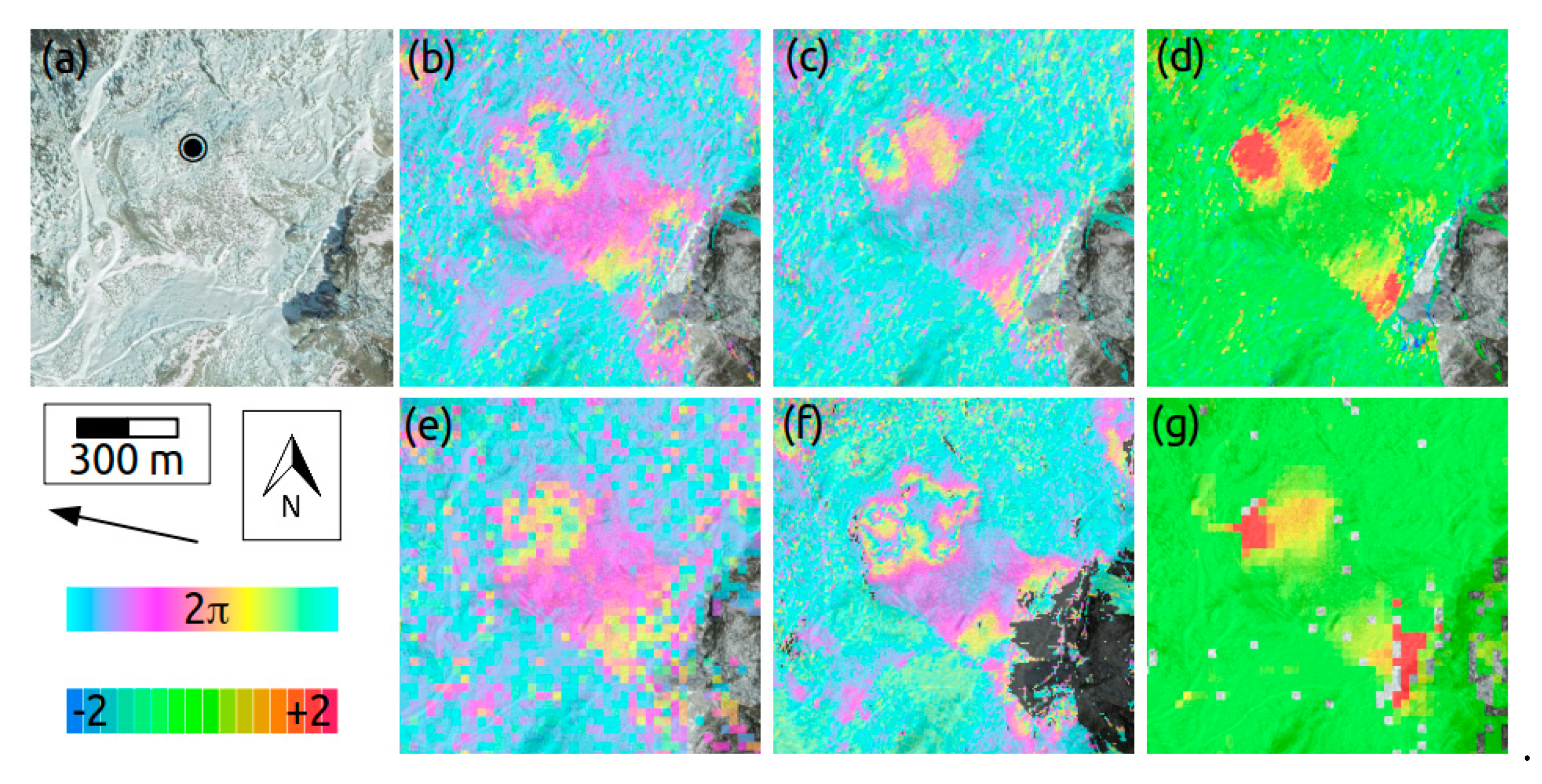

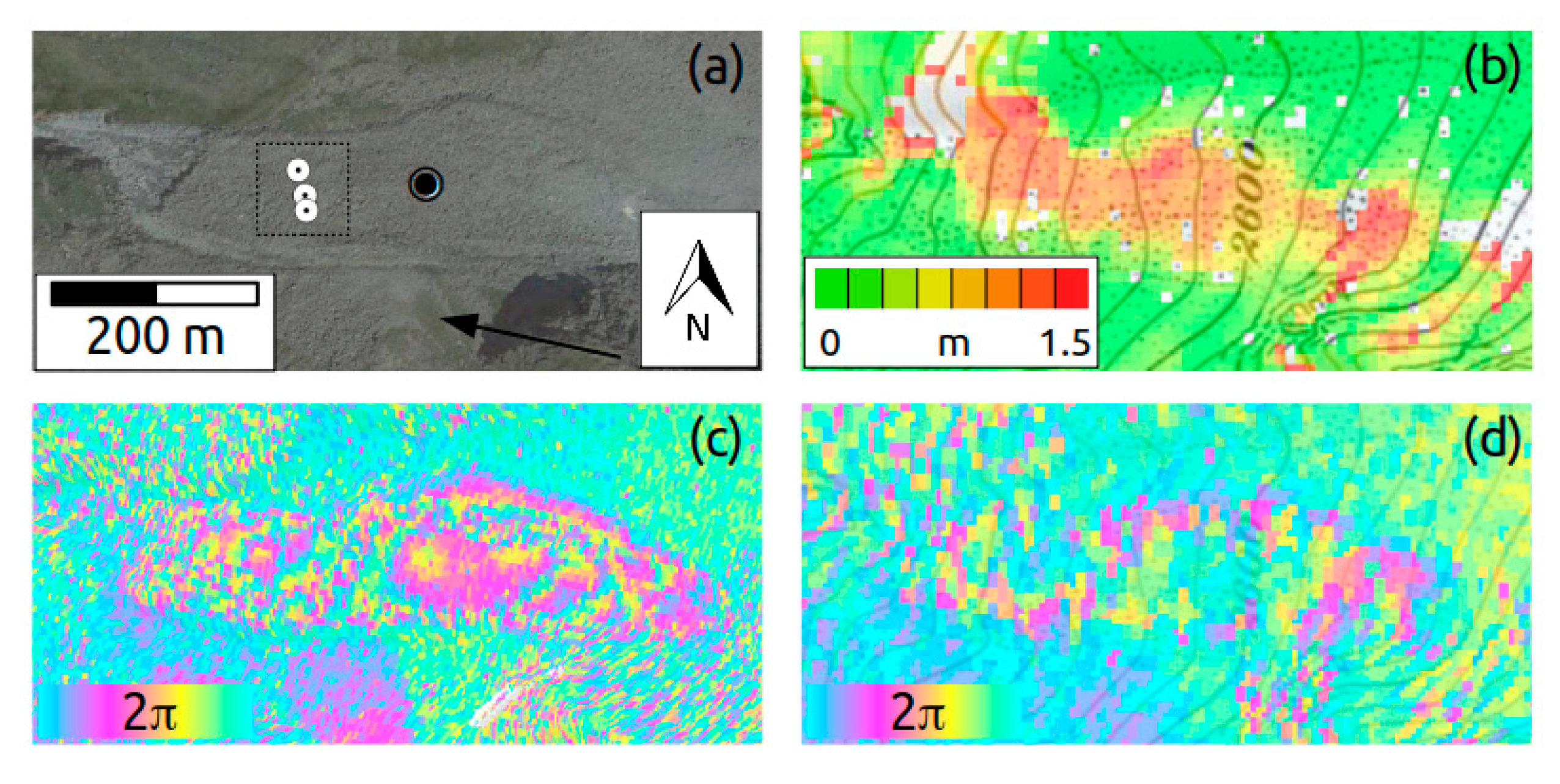


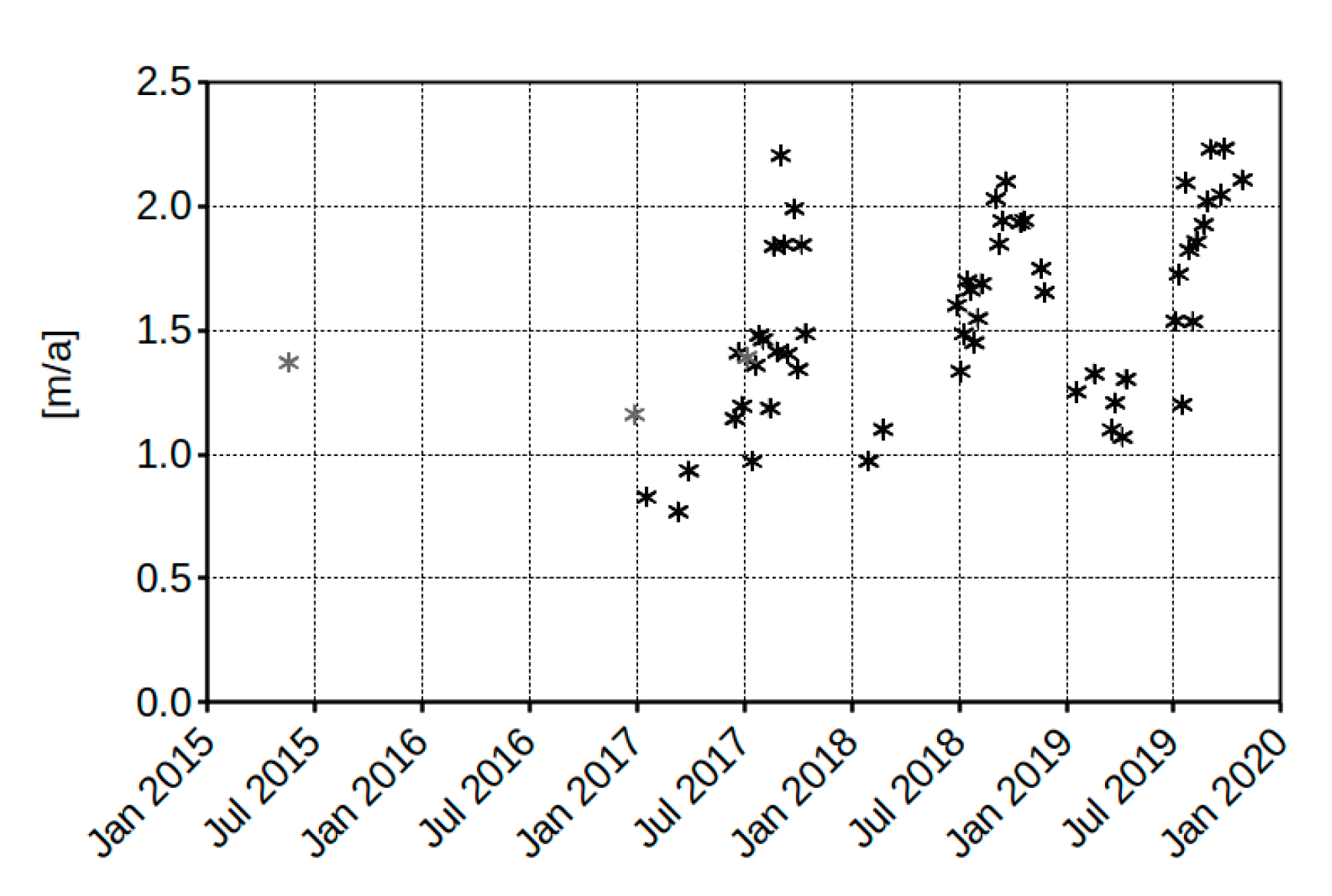
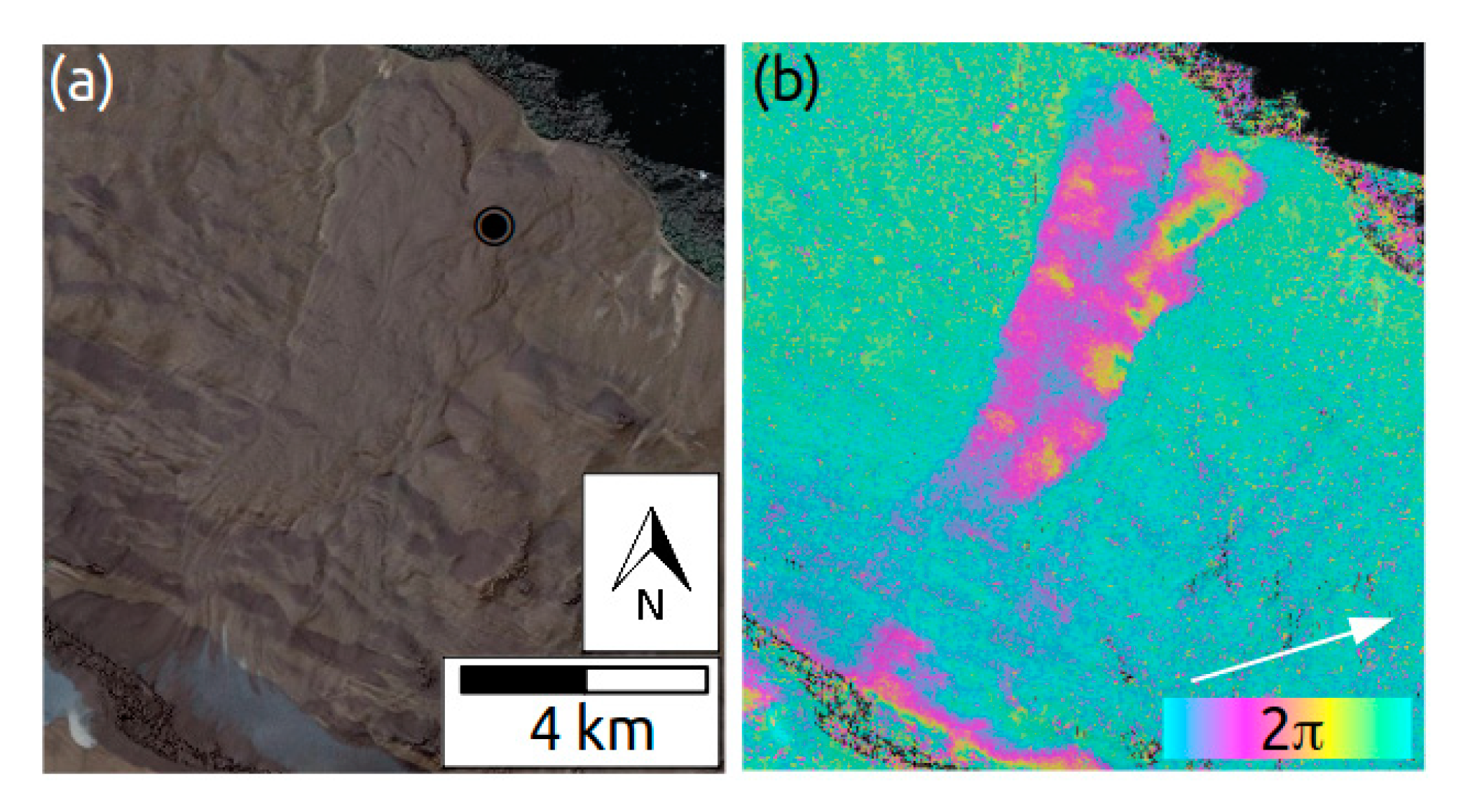
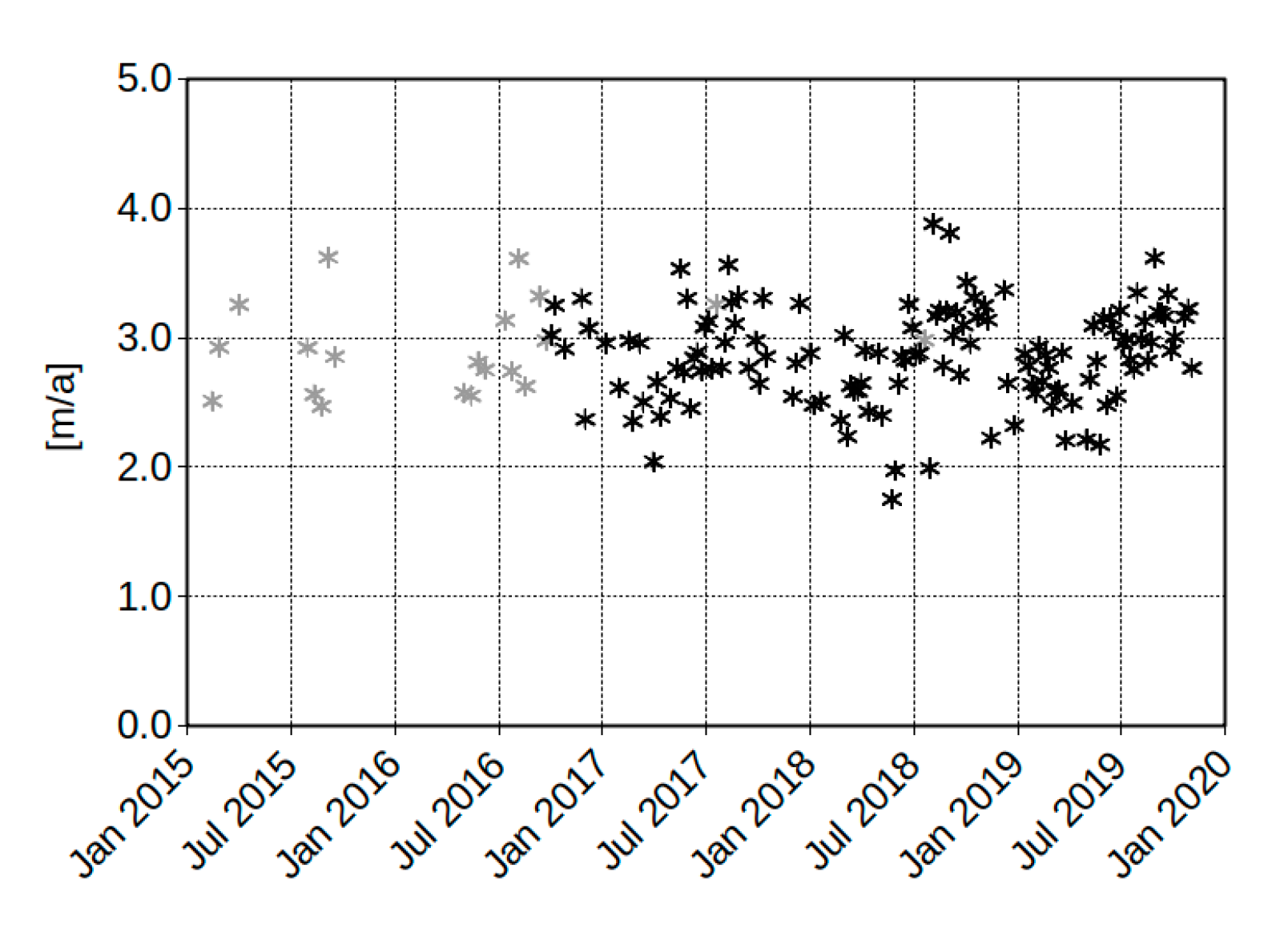

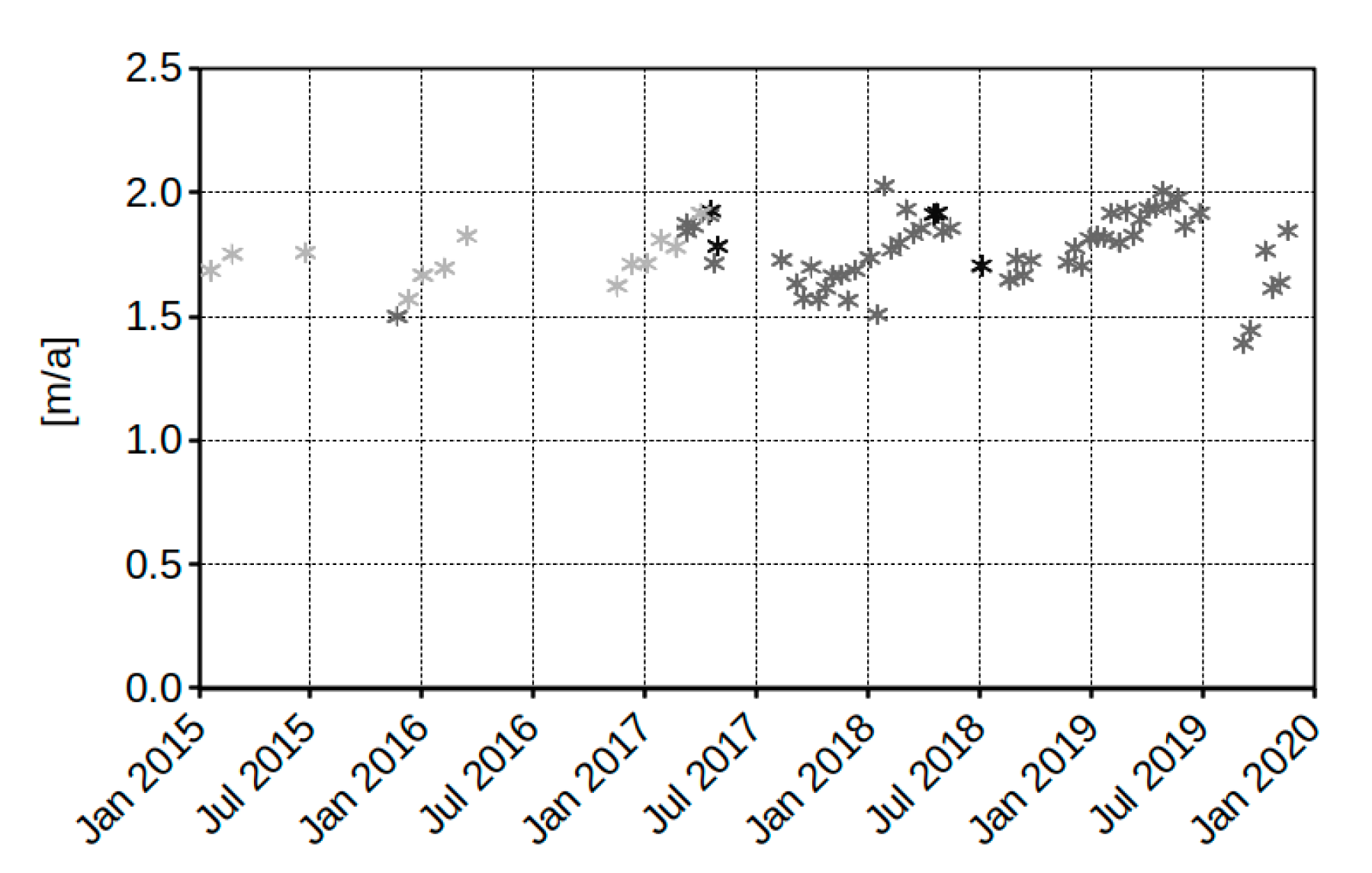
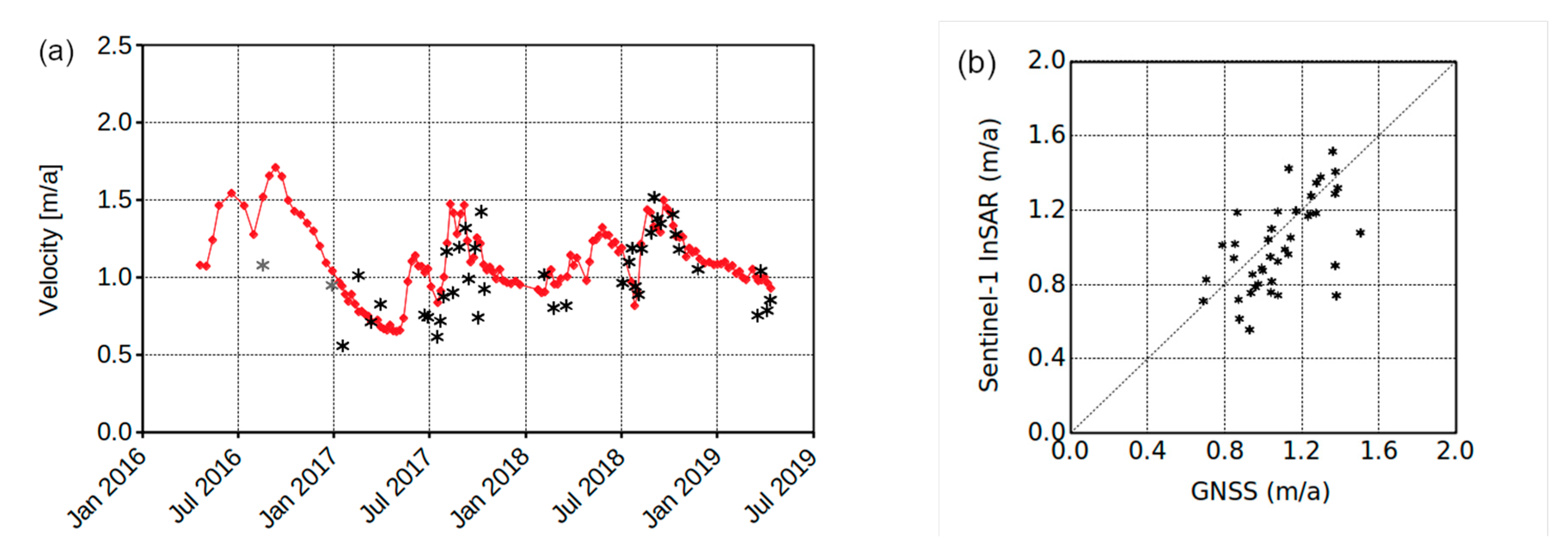
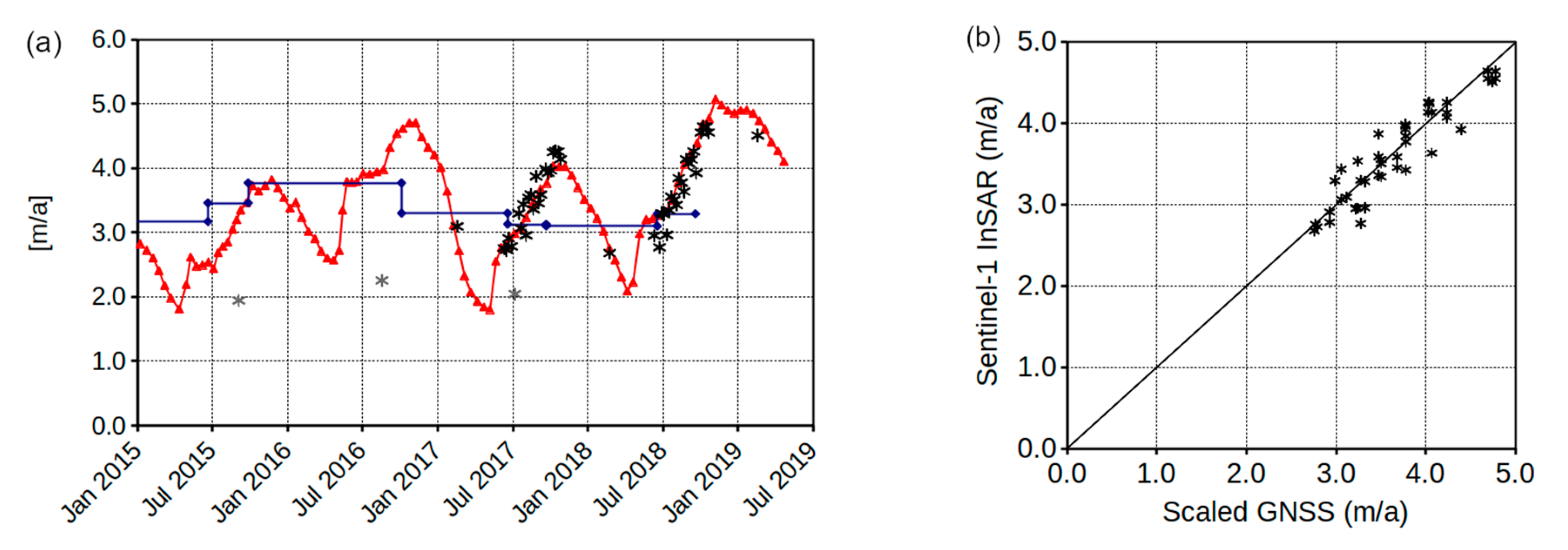
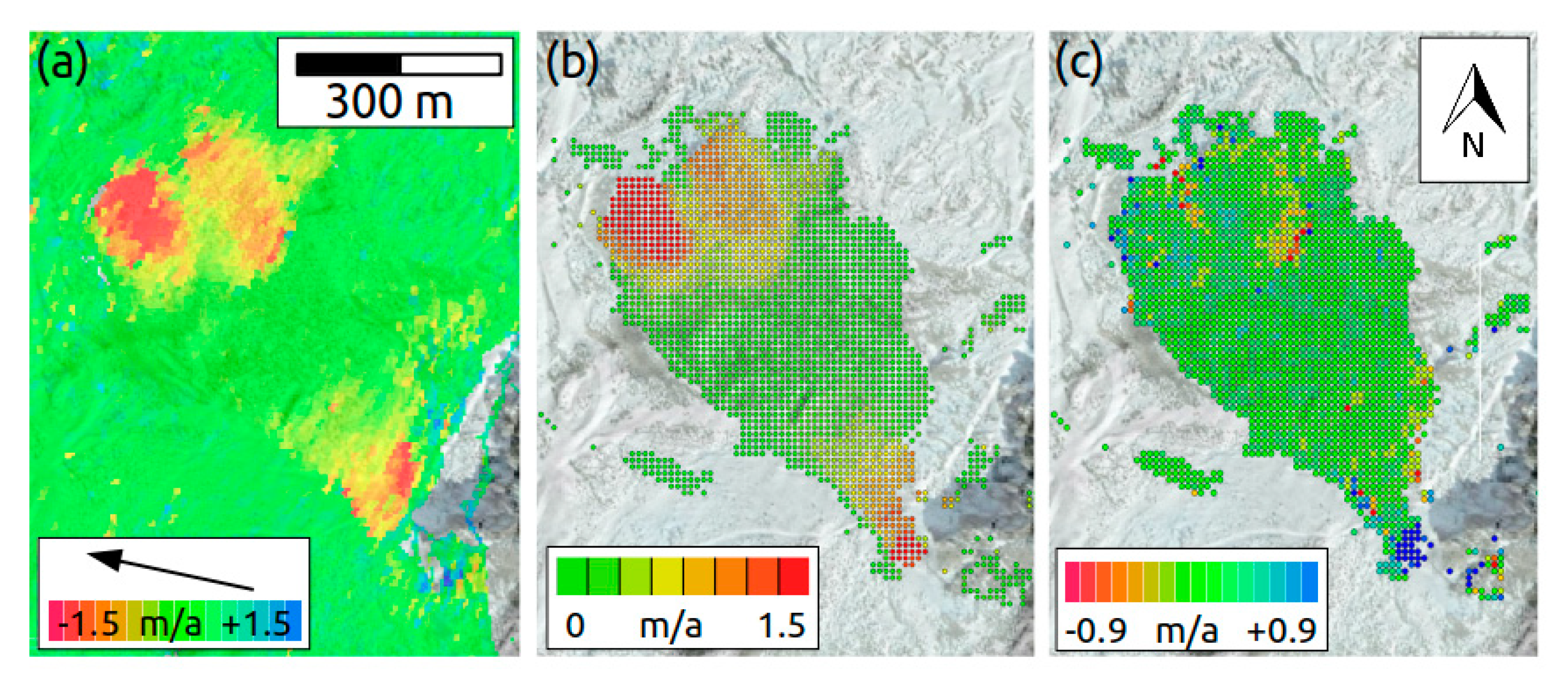
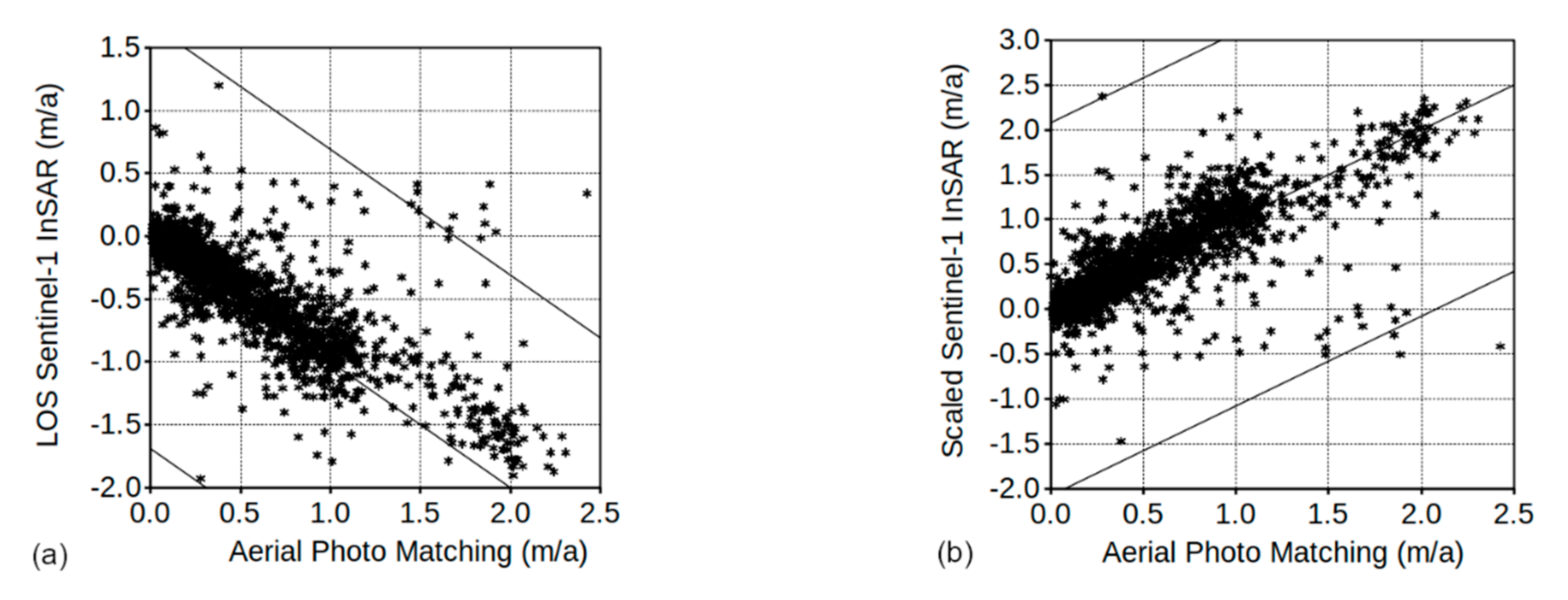

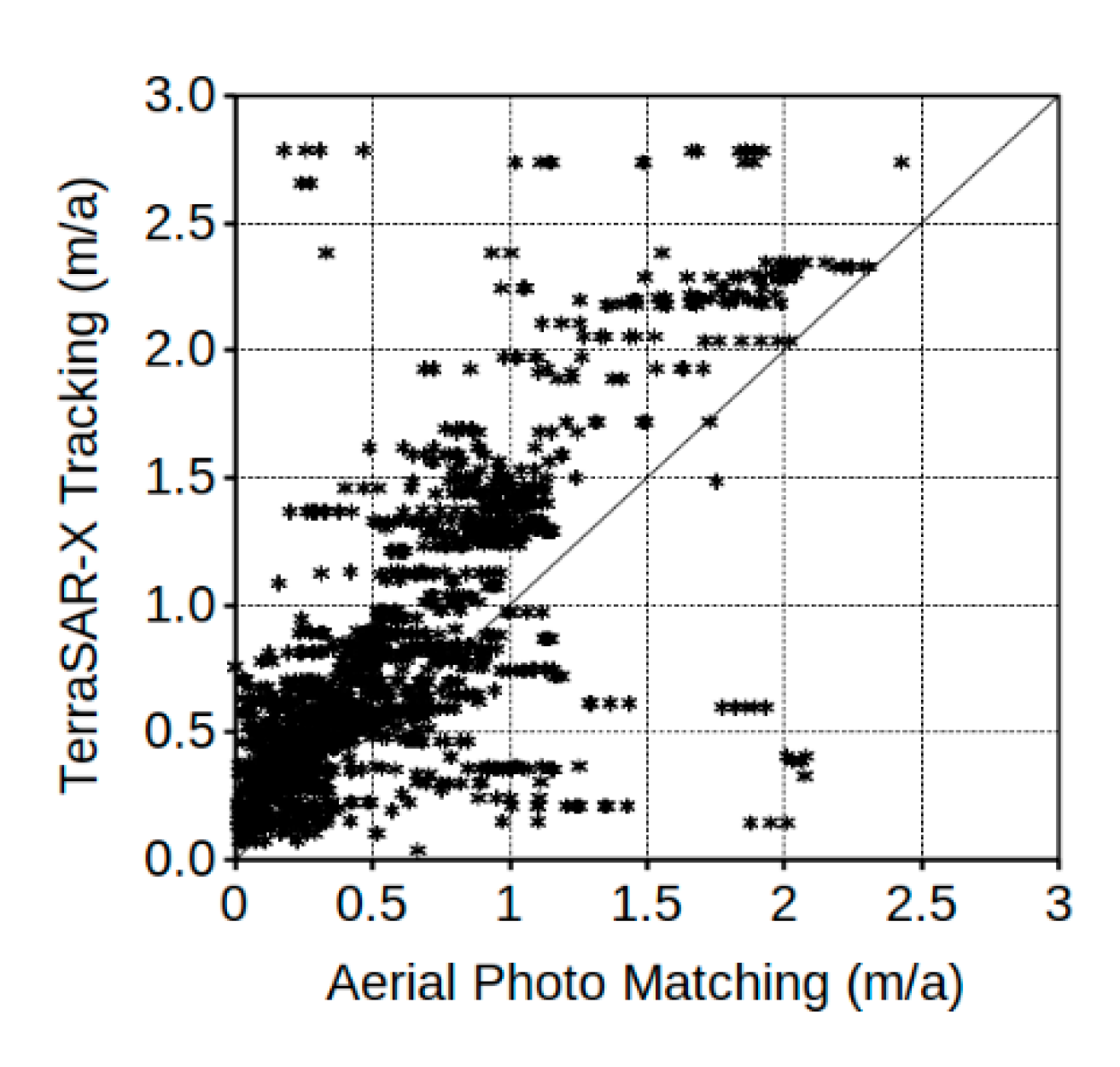
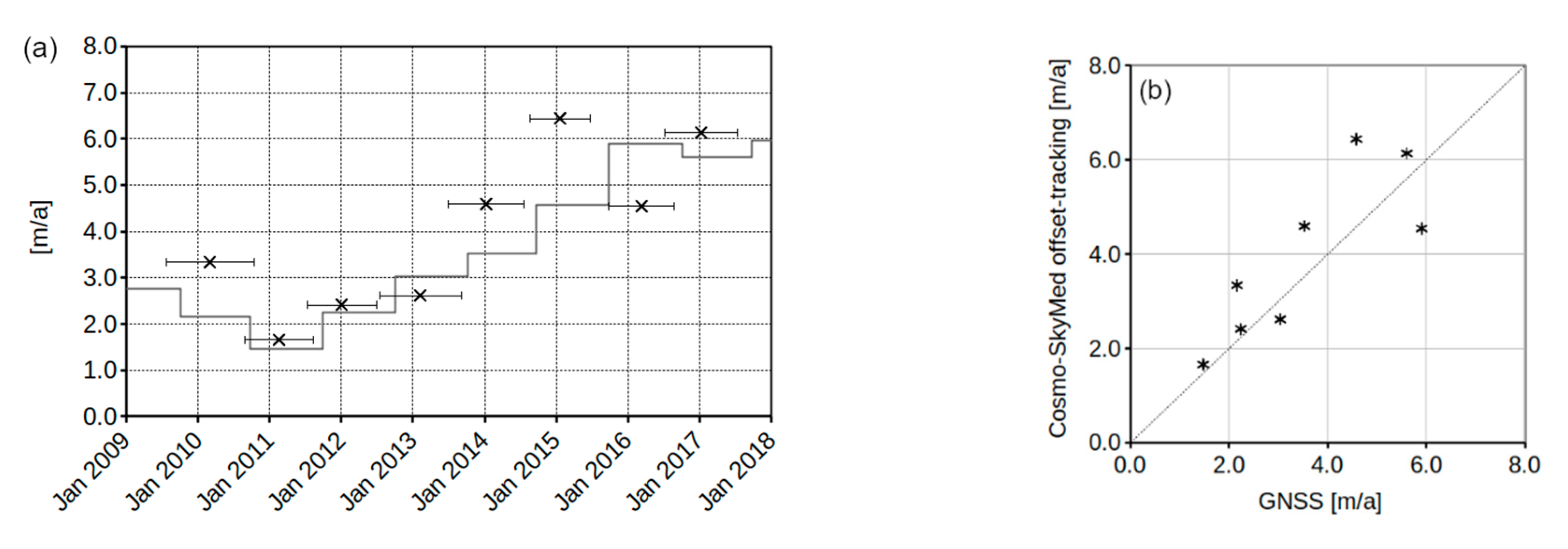
| Study Region | Satellite Sensor | Acquisition Mode | Nominal Acquisition Time Interval | Time Period | Pixel Resolution (range × azimuth) |
|---|---|---|---|---|---|
| Western Swiss Alps | JERS-1 | Stripmap | 44 days | 1996 | 8.8 m × 4.5 m |
| TerraSAR-X | Stripmap | 11 days | 2008–2016 | 1.4 m × 2.0 m | |
| Cosmo-SkyMed | Stripmap | 16 days | 2009–2017 | 1.0 m × 2.3 m | |
| Sentinel-1 | TOPS IWS | 6 days | 2015–2019 | 2.3 m × 13.9 m | |
| Qeqertarsuaq | Sentinel-1 | TOPS IWS | 6 days | 2015–2019 | 2.3 m × 13.9 m |
| Tapado/Agua Negra | Sentinel-1 | TOPS IWS | 12 days | 2015–2019 | 2.3 m × 13.9 m |
© 2020 by the authors. Licensee MDPI, Basel, Switzerland. This article is an open access article distributed under the terms and conditions of the Creative Commons Attribution (CC BY) license (http://creativecommons.org/licenses/by/4.0/).
Share and Cite
Strozzi, T.; Caduff, R.; Jones, N.; Barboux, C.; Delaloye, R.; Bodin, X.; Kääb, A.; Mätzler, E.; Schrott, L. Monitoring Rock Glacier Kinematics with Satellite Synthetic Aperture Radar. Remote Sens. 2020, 12, 559. https://doi.org/10.3390/rs12030559
Strozzi T, Caduff R, Jones N, Barboux C, Delaloye R, Bodin X, Kääb A, Mätzler E, Schrott L. Monitoring Rock Glacier Kinematics with Satellite Synthetic Aperture Radar. Remote Sensing. 2020; 12(3):559. https://doi.org/10.3390/rs12030559
Chicago/Turabian StyleStrozzi, Tazio, Rafael Caduff, Nina Jones, Chloé Barboux, Reynald Delaloye, Xavier Bodin, Andreas Kääb, Eva Mätzler, and Lothar Schrott. 2020. "Monitoring Rock Glacier Kinematics with Satellite Synthetic Aperture Radar" Remote Sensing 12, no. 3: 559. https://doi.org/10.3390/rs12030559
APA StyleStrozzi, T., Caduff, R., Jones, N., Barboux, C., Delaloye, R., Bodin, X., Kääb, A., Mätzler, E., & Schrott, L. (2020). Monitoring Rock Glacier Kinematics with Satellite Synthetic Aperture Radar. Remote Sensing, 12(3), 559. https://doi.org/10.3390/rs12030559






